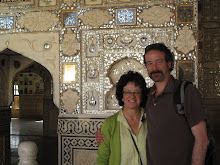
We visited the Taj Mahal on our second to last day in India and it was every bit as marvelous as it was purported to be. It was built between 1631 to 1653 by the Emperor Shah Jahan (and 20,000 workers) as a memorial to his second wife, Mumtaz, who died giving birth to their 14th child. Not long after it was finished, Shah Jahan was overthrown by his son and imprisoned in the Agra Fort where he could only gaze upon his creation from afar. He is buried in the Taj alongside his wife. Rumor has it that Shah Jahan had plans to build a mirror-image Taj of black marble on the opposite river bank and that’s why he was thrown in prison –the Mughal empire couldn’t afford his exorbitant spending. I am certainly glad for his megalomania several hundred years later as is the Indian government, I’m sure!

The Taj sits on the river bank at an angle so that when you walk towards it, it looks like it’s floating in the clouds and the surrounding gardens and reflecting pools are its anchor. More than just the size of the teardrop dome and perfect symmetry of the minarets (although they do lean in towards each other) the white marble is stunning, with gorgeous inlaid marble and semi-precious stones depicting flowers and Arabic quotations from the Quran.
As evidenced by our pictures, it possible to take shots of the Taj with very few people in the foreground because of size of the gardens and the many raised areas along the reflecting pools. There were a lot of people there but not so many that it felt crowded. It is really very peaceful and even more serene on the riverside of the dome. (Although there isn’t much of view from that direction …just a dried-up riverbed.)

This was the only place in India where we saw or heard any Americans, as well as people from all over the world, of course. It is truly a marvel to behold. I won't say any more because Peter's pictures say it all.














